trailer CITROEN DS5 2016 Owners Manual
[x] Cancel search | Manufacturer: CITROEN, Model Year: 2016, Model line: DS5, Model: CITROEN DS5 2016Pages: 403, PDF Size: 15.62 MB
Page 6 of 403
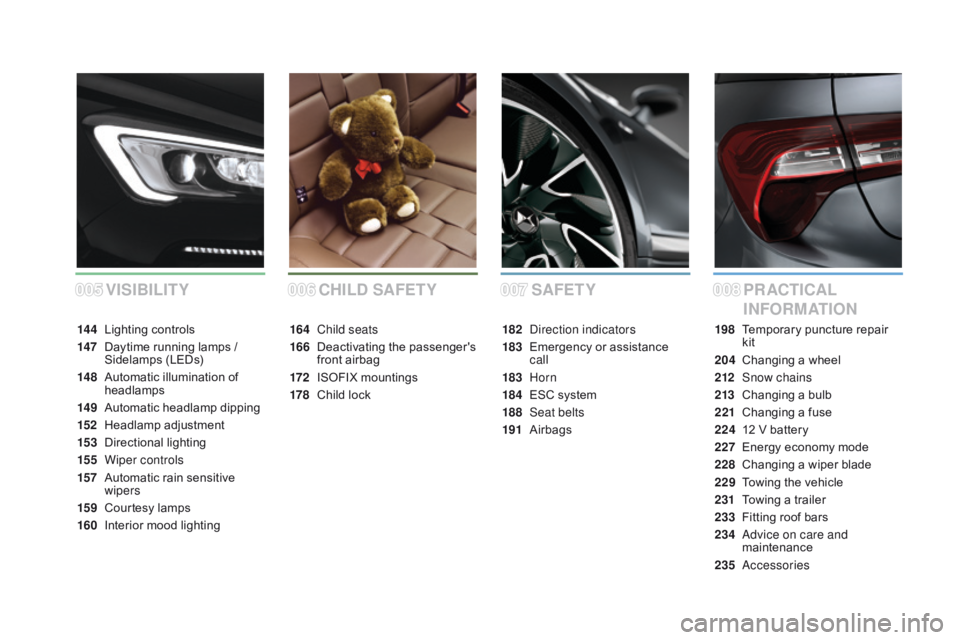
005006007008
DS5_en_Chap00a_sommaire_ed01-2015
SAFETYPR A cT IcA L
INFORMATIONc
HILd S
AFETYvI
SIBILITY
14 4 Lighting controls
147
D
aytime running lamps /
Sidelamps (LEDs)
14 8
A
utomatic illumination of
headlamps
14 9
A
utomatic headlamp dipping
152
H
eadlamp adjustment
153
D
irectional lighting
155
W
iper controls
157
A
utomatic rain sensitive
wipers
15 9
C
ourtesy lamps
160
I
nterior mood lighting 164 Ch
ild seats
166
D
eactivating the passenger's
front airbag
172
I
SOFIX mountings
178
C
hild lock182 D
irection indicators
183
E
mergency or assistance
call
183
H
orn
184
ES
C system
188
Se
at belts
191
A
irbags198 T
emporary puncture repair
kit
204
C
hanging a wheel
212
S
now chains
213
C
hanging a bulb
221
C
hanging a fuse
224
1
2 V battery
227
E
nergy economy mode
228
C
hanging a wiper blade
229
T
owing the vehicle
231
T
owing a trailer
233
F
itting roof bars
234
A
dvice on care and
maintenance
235
A
ccessories
Page 17 of 403
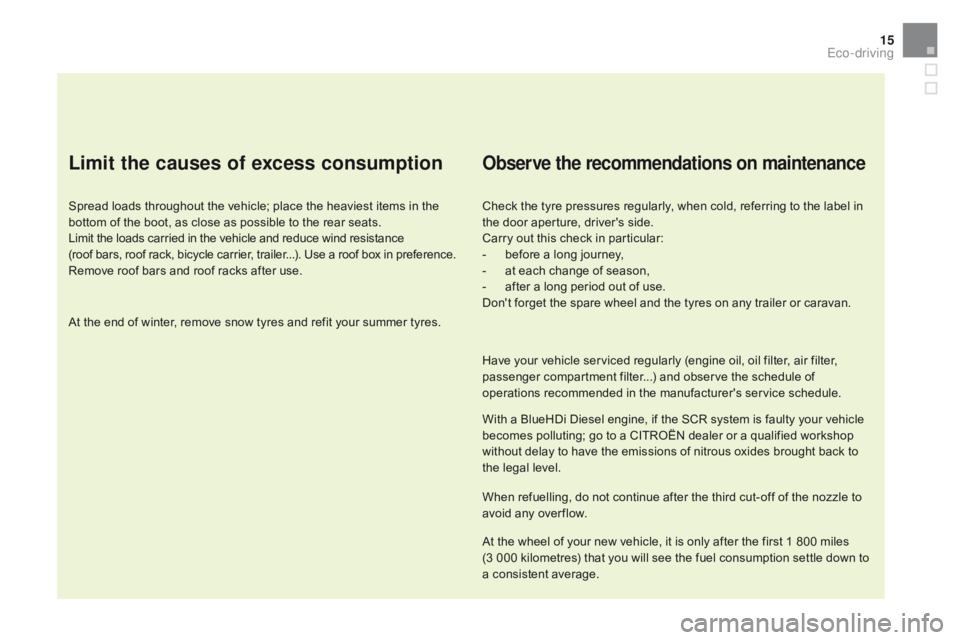
15
DS5_en_Chap00c_eco-conduite_ed01-2015
Limit the causes of excess consumption
Spread loads throughout the vehicle; place the heaviest items in the
bottom of the boot, as close as possible to the rear seats.
Limit the loads carried in the vehicle and reduce wind resistance
(roof bars, roof rack, bicycle carrier, trailer...). Use a roof box in preference.
Remove roof bars and roof racks after use.
At the end of winter, remove snow tyres and refit your summer tyres.
Observe the recommendations on maintenance
Check the tyre pressures regularly, when cold, referring to the label in
the door aperture, driver's side.
Carry out this check in particular:
-
b
efore a long journey,
-
a
t each change of season,
-
a
fter a long period out of use.
Don't forget the spare wheel and the tyres on any trailer or caravan.
Have your vehicle serviced regularly (engine oil, oil filter, air filter,
passenger compartment filter...) and observe the schedule of
operations recommended in the manufacturer's service schedule.
With a BlueHDi Diesel engine, if the SCR system is faulty your vehicle
becomes polluting; go to a CITROËN dealer or a qualified workshop
without delay to have the emissions of nitrous oxides brought back to
the legal level.
When refuelling, do not continue after the third cut-off of the nozzle to
avoid any over flow.
At the wheel of your new vehicle, it is only after the first 1 800 miles
(3 000 kilometres) that you will see the fuel consumption settle down to
a consistent average.
Eco-driving
Page 105 of 403
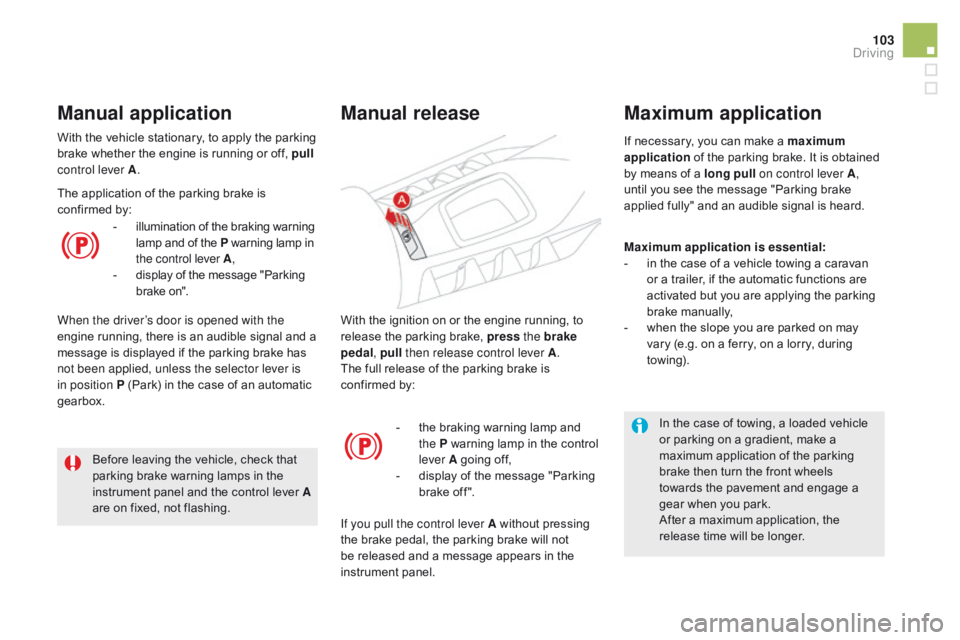
103
DS5_en_Chap04_conduite_ed01-2015
With the ignition on or the engine running, to
release the parking brake, press the brake
pedal , pull then release control lever A .
The full release of the parking brake is
confirmed by:
Manual release
- the braking warning lamp and the P warning lamp in the control
lever A going off,
-
d
isplay of the message "Parking
brake off ".
If you pull the control lever A without pressing
the brake pedal, the parking brake will not
be released and a message appears in the
instrument panel.
Before leaving the vehicle, check that
parking brake warning lamps in the
instrument panel and the control lever A
are on fixed, not flashing.
With the vehicle stationary, to apply the parking
brake whether the engine is running or off, pull
control lever A .
Manual application
The application of the parking brake is
confirmed by:
-
i
llumination of the braking warning
lamp and of the P warning lamp in
the control lever A ,
-
d
isplay of the message "Parking
brake on".
When the driver’s door is opened with the
engine running, there is an audible signal and a
message is displayed if the parking brake has
not been applied, unless the selector lever is
in position P (Park) in the case of an automatic
gearbox. Maximum application is essential:
-
i
n the case of a vehicle towing a caravan
or a trailer, if the automatic functions are
activated but you are applying the parking
brake manually,
-
w
hen the slope you are parked on may
vary (e.g. on a ferry, on a lorry, during
towing).
If necessary, you can make a maximum
application
of the parking brake. It is obtained
by means of a long pull on control lever A,
until you see the message "Parking brake
applied fully" and an audible signal is heard.
In the case of towing, a loaded vehicle
or parking on a gradient, make a
maximum application of the parking
brake then turn the front wheels
towards the pavement and engage a
gear when you park.
After a maximum application, the
release time will be longer.
Maximum application
driving
Page 129 of 403
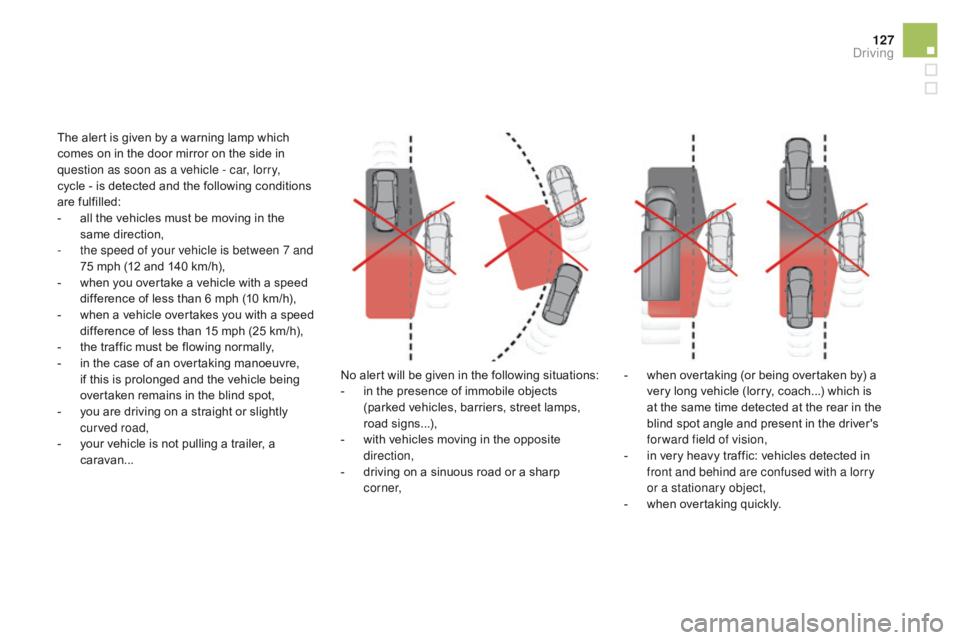
127
DS5_en_Chap04_conduite_ed01-2015
The alert is given by a warning lamp which
comes on in the door mirror on the side in
question as soon as a vehicle - car, lorry,
cycle - is detected and the following conditions
are fulfilled:
-
a
ll the vehicles must be moving in the
same direction,
-
t
he speed of your vehicle is between 7 and
75 mph (12 and 140 km/h),
-
w
hen you overtake a vehicle with a speed
difference of less than 6 mph (10 km/h),
-
w
hen a vehicle overtakes you with a speed
difference of less than 15 mph (25 km/h),
-
t
he traffic must be flowing normally,
-
i
n the case of an overtaking manoeuvre,
if this is prolonged and the vehicle being
overtaken remains in the blind spot,
-
y
ou are driving on a straight or slightly
curved road,
-
y
our vehicle is not pulling a trailer, a
caravan... No alert will be given in the following situations:
-
i
n the presence of immobile objects
(parked vehicles, barriers, street lamps,
road signs...),
-
w
ith vehicles moving in the opposite
direction,
-
d
riving on a sinuous road or a sharp
c o r n e r, -
w
hen overtaking (or being overtaken by) a
very long vehicle (lorry, coach...) which is
at the same time detected at the rear in the
blind spot angle and present in the driver's
forward field of vision,
-
i
n very heavy traffic: vehicles detected in
front and behind are confused with a lorry
or a stationary object,
-
w
hen overtaking quickly.
driving
Page 142 of 403
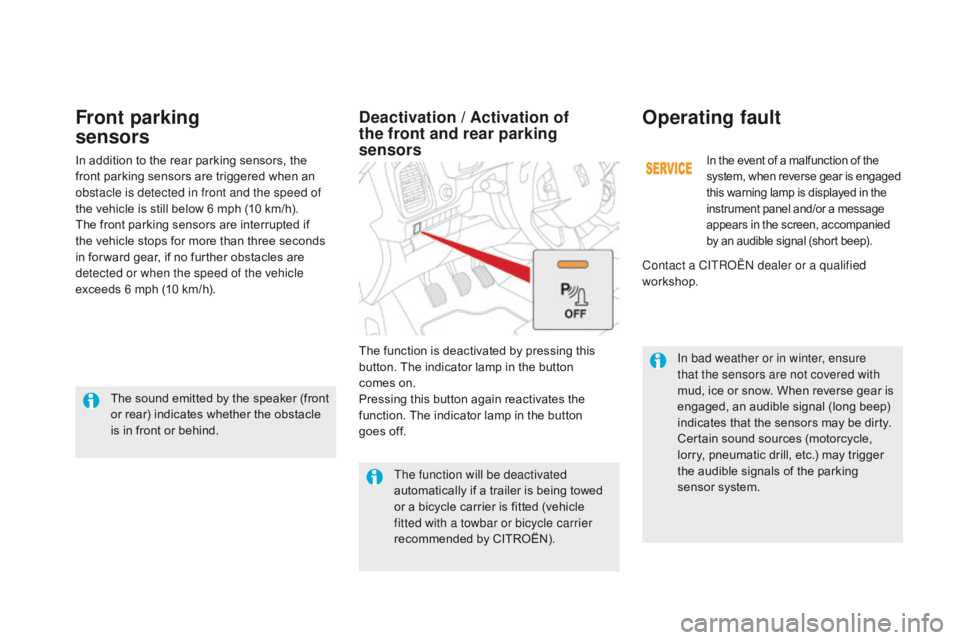
DS5_en_Chap04_conduite_ed01-2015
In bad weather or in winter, ensure
that the sensors are not covered with
mud, ice or snow. When reverse gear is
engaged, an audible signal (long beep)
indicates that the sensors may be dirty.
Certain sound sources (motorcycle,
lorry, pneumatic drill, etc.) may trigger
the audible signals of the parking
sensor system.
In the event of a malfunction of the
system, when reverse gear is engaged
this warning lamp is displayed in the
instrument panel and/or a message
appears in the screen, accompanied
by an audible signal (short beep).
Operating fault
In addition to the rear parking sensors, the
front parking sensors are triggered when an
obstacle is detected in front and the speed of
the vehicle is still below 6 mph (10 km/h).
The front parking sensors are interrupted if
the vehicle stops for more than three seconds
in for ward gear, if no further obstacles are
detected or when the speed of the vehicle
exceeds 6 mph (10 km/h).
Front parking
sensors
The function will be deactivated
automatically if a trailer is being towed
or a bicycle carrier is fitted (vehicle
fitted with a towbar or bicycle carrier
recommended by CITROËN).
deactivation / Activation of
the front and rear parking
sensors
The function is deactivated by pressing this
button. The indicator lamp in the button
comes on.
Pressing this button again reactivates the
function. The indicator lamp in the button
goes off.
The sound emitted by the speaker (front
or rear) indicates whether the obstacle
is in front or behind. Contact a CITROËN dealer or a qualified
workshop.
Page 233 of 403

231
DS5_en_Chap08_info-pratiques_ed01-2015
Towing a trailer
We recommend the use of genuine
CITROËN towbars and their harnesses
that have been tested and approved
from the design stage of your vehicle,
and that the fitting of the towbar is
entrusted to a CITROËN dealer or a
qualified workshop.
If the towbar is not fitted by a
CITROËN dealer, it must still be
fitted in accordance with the vehicle
manufacturer's instructions.
Your vehicle is primarily designed for
transporting people and luggage, but it may
also be used for towing a trailer.
When not towing a trailer, remove the
quickly-detachable tow ball before
driving, so as to avoid masking the
central rear lamp. Driving with a trailer places greater
demands on the towing vehicle and the
driver must take particular care.
Practical information
Page 234 of 403
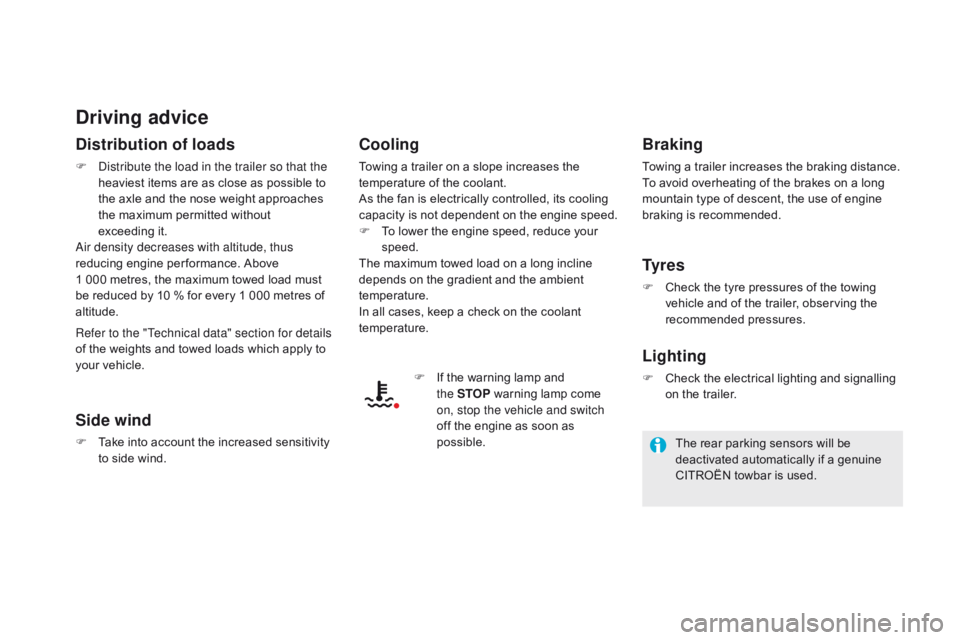
DS5_en_Chap08_info-pratiques_ed01-2015
driving advice
distribution of loads
F Distribute the load in the trailer so that the heaviest items are as close as possible to
the axle and the nose weight approaches
the maximum permitted without
exceeding
it.
Air density decreases with altitude, thus
reducing engine per formance. Above
1
000 metres, the maximum towed load must
be reduced by 10
% for every 1 000 metres of
altitude.
Side wind
F Take into account the increased sensitivity to side wind.
cooling
Towing a trailer on a slope increases the
temperature of the coolant.
As the fan is electrically controlled, its cooling
capacity is not dependent on the engine speed.
F
T
o lower the engine speed, reduce your
speed.
The maximum towed load on a long incline
depends on the gradient and the ambient
temperature.
In all cases, keep a check on the coolant
temperature.
F
I
f the warning lamp and
the
STOP warning lamp come
on, stop the vehicle and switch
off the engine as soon as
possible.
Braking
Towing a trailer increases the braking distance.
To avoid overheating of the brakes on a long
mountain type of descent, the use of engine
braking is recommended.
Ty r e s
F Check the tyre pressures of the towing vehicle and of the trailer, observing the
recommended pressures.
Lighting
F Check the electrical lighting and signalling on the trailer.
Refer to the "Technical data" section for details
of the weights and towed loads which apply to
your vehicle.
The rear parking sensors will be
deactivated automatically if a genuine
CITROËN towbar is used.
Page 269 of 403
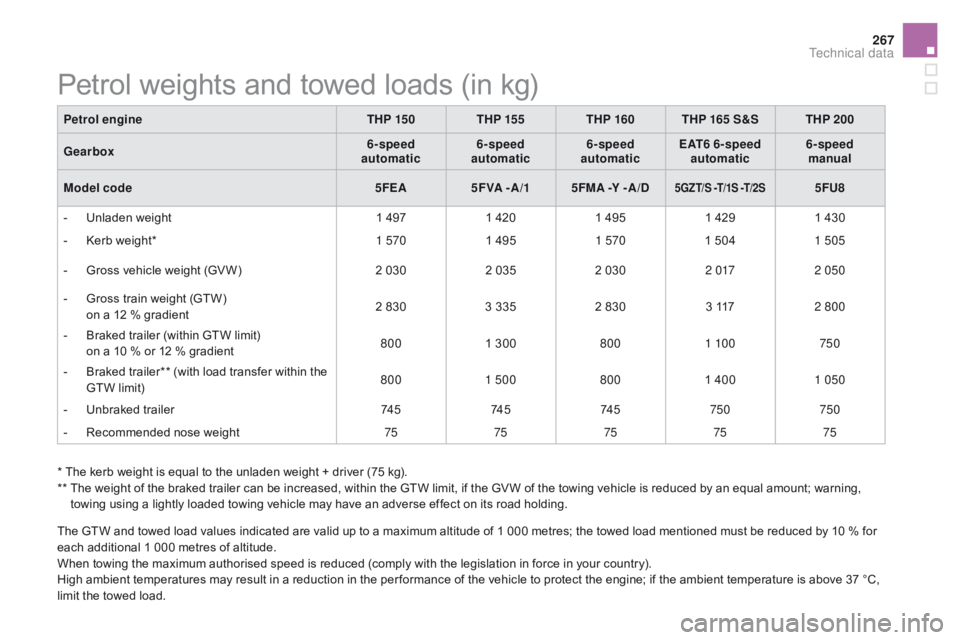
267
DS5_en_Chap10_caracteristiques_ed01-2015
Petrol weights and towed loads (in kg)
Petrol engineTHP 15 0THP 155 THP 160 THP 165 S&S THP 200
Gearbox 6-speed
automatic 6-speed
automatic 6-speed
automatic EAT6 6-speed
automatic 6-speed
manual
Model code 5FEA5 F
v
A - A /15FMA -Y -A /
d5GZT/S -T/1S -T/2S5FU8
-
U
nladen weight 1 4971 4201 495 1 4291 430
-
K
erb weight* 1 5701 495 1 5701 504 1 505
-
G
ross vehicle weight (GV W) 2 0302 0352 030 2 0172 050
-
G
ross train weight (GTW)
o
n a 12 % gradient 2 830
3 3352 830 3 1172 800
-
B
raked trailer (within GTW limit)
o
n a 10 % or 12 % gradient 800
1 300 8001 10 0 750
-
B
raked trailer** (with load transfer within the
GTW limit) 800
1 500 8001 400 1 050
-
U
nbraked trailer 74 574 574 5750 750
-
R
ecommended nose weight 7575757575
* The kerb weight is equal to the unladen weight + driver (75 kg).
**
T
he weight of the braked trailer can be increased, within the GTW limit, if the GV W of the towing vehicle is reduced by an equal amount; warning,
towing using a lightly loaded towing vehicle may have an adverse effect on its road holding.
The GTW and towed load values indicated are valid up to a maximum altitude of 1 000 metres; the towed load mentioned must be reduced by 10 % for
each additional 1 000 metres of altitude.
When towing the maximum authorised speed is reduced (comply with the legislation in force in your country).
High ambient temperatures may result in a reduction in the per formance of the vehicle to protect the engine; if the ambient temperature is above 37 °C,
limit the towed load.
Technical data
Page 270 of 403
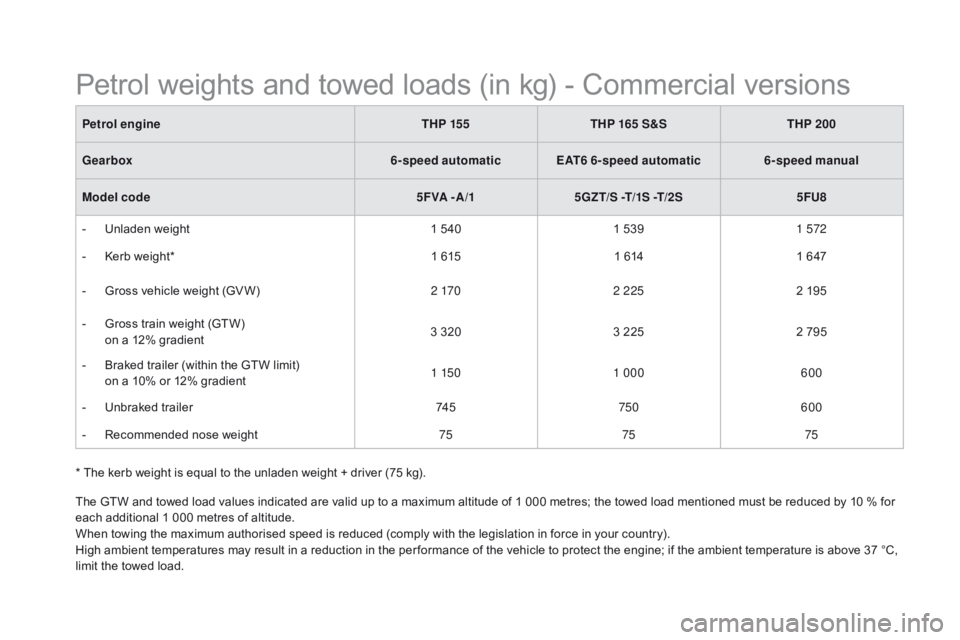
DS5_en_Chap10_caracteristiques_ed01-2015
* The kerb weight is equal to the unladen weight + driver (75 kg).Petrol engine
THP 155THP 165 S&S THP 200
Gearbox 6-speed automaticEAT6 6-speed automatic 6-speed manual
Model code 5 F
v
A - A /1
5GZT/S -T/1S -T/2S 5FU8
-
U
nladen weight
1 5401 539 1 572
-
K
erb weight*
1 6151 6141 647
-
G
ross vehicle weight (GV W)
2 1702 225 2 195
-
G
ross train weight (GTW)
o
n a 12% gradient
3 320
3 225 2 795
-
B
raked trailer (within the GTW limit)
o
n a 10% or 12% gradient
1 150
1 000 600
-
U
nbraked trailer
74 5750600
-
R
ecommended nose weight
757575
The GTW and towed load values indicated are valid up to a maximum altitude of 1 000 metres; the towed load mentioned must be reduced by 10 % for
each additional 1 000 metres of altitude.
When towing the maximum authorised speed is reduced (comply with the legislation in force in your country).
High ambient temperatures may result in a reduction in the per formance of the vehicle to protect the engine; if the ambient temperature is above 37 °C,
limit the towed load.
Petrol weights and towed loads (in kg) - Commercial versions
Page 274 of 403
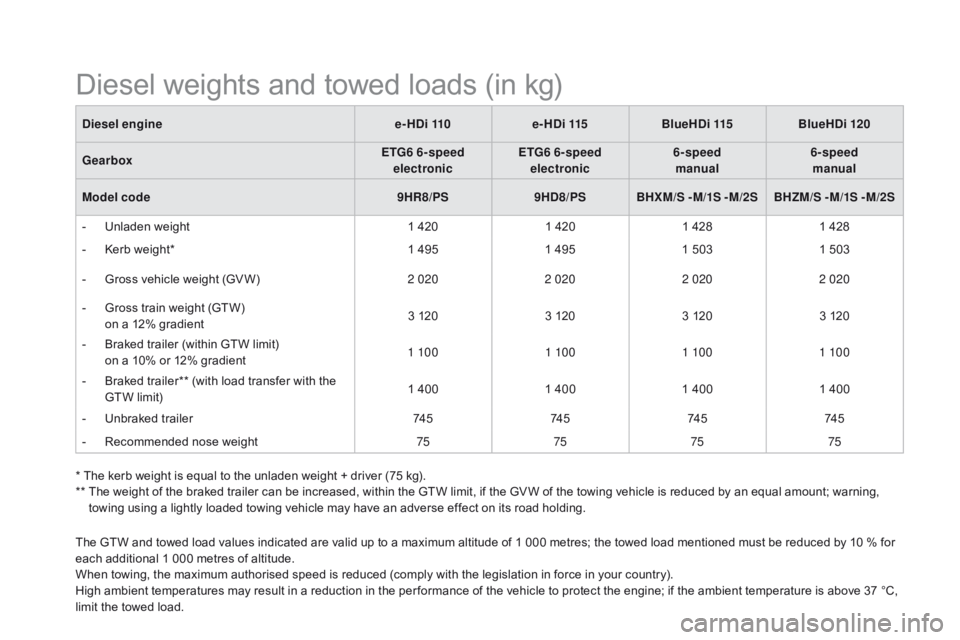
DS5_en_Chap10_caracteristiques_ed01-2015
The GTW and towed load values indicated are valid up to a maximum altitude of 1 000 metres; the towed load mentioned must be reduced by 10 % for
each additional 1 000 metres of altitude.
When towing, the maximum authorised speed is reduced (comply with the legislation in force in your country).
High ambient temperatures may result in a reduction in the per formance of the vehicle to protect the engine; if the ambient temperature is above 37 °C,
limit the towed load. * The kerb weight is equal to the unladen weight + driver (75 kg).
**
T
he weight of the braked trailer can be increased, within the GTW limit, if the GV W of the towing vehicle is reduced by an equal amount; warning,
towing using a lightly loaded towing vehicle may have an adverse effect on its road holding.
di
esel engine
e-H d i 110
e-H d i 115
BlueH d i 115
BlueH d i 120
Gearbox ETG6 6-speed
electronic ETG6 6-speed
electronic 6-speed
manual 6-speed
manual
Model code 9HR8/PS9H
d8
/PS
BHXM/S -M/1S -M/2S BHZM/S -M/1S -M/2S
-
U
nladen weight
1 4201 420 1 4281 428
-
K
erb weight*
1 4951 4951 5031 503
-
G
ross vehicle weight (GV W)
2 0202 0202 0202 020
-
G
ross train weight (GTW)
o
n a 12% gradient
3 120
3 1203 1203 120
-
B
raked trailer (within GTW limit)
o
n a 10% or 12% gradient
1 10 0
1 10 01 10 01 10 0
-
B
raked trailer** (with load transfer with the
GTW limit) 1 400
1 4001 4001 400
-
U
nbraked trailer
74 574 574 574 5
-
R
ecommended nose weight
75757575
Diesel weights and towed loads (in kg)